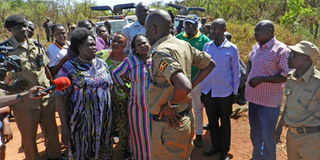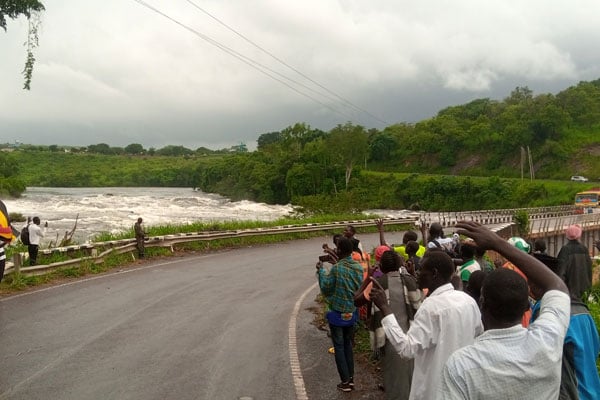Leaders divided over MPs’ proposals on Apaa land

Leader of Opposition in Parliament Betty Aol Ocan (left) confronts security officers at a roadblock near Apaa centre last year after MPs were blocked from meeting residents. PHOTO | TOBBIAS JOLLY OWINY
What you need to know:
- In 2015, government begun demarcating administrative boundaries between Amuru and Adjumani districts in what it described as a move to restore calm among communities settled on the land. However, this resulted in violence by the two communities that later saw police and the army deploy in the area.
Leaders in the disputed Apaa land have disagreed over a parliamentary resolution staying any plans to relocate or evict people residing in the contested area.
Last year, Parliament established a committee and tasked it to investigate the state of affairs relating to the land conflicts in the Apaa community and determine the root cause of the conflicts and internal displacements of persons.
The six-member committee, chaired by Butebo Woman MP Agnes Ameede, was also tasked to recommend a lasting solution to the conflict. It presented the findings before the House last week.
Mr Ojara Okin, the chairperson of Acholi Parliamentary Group, said they were satisfied with the findings although they were worried about government implementing the recommendations.
“Our worry as leaders from the Acholi side is that government (Uganda Wildlife Authority (UWA) and the army) may not care so much about these recommendations,” Mr Okin said.
However, Mr James Leku, the Adjumani District chairman, told Daily Monitor that they disagree with the report because it conflicts with the district position and findings of the previous committees.
“It is a biased report without evidence, and it is a total departure from the previous committee reports. We don’t agree with the proposal for degazetting, for whom are they degazetting? It will instead cause more conflicts since human greed for land never ends,” Mr Leku said.
Although he said they were happy that the committee pointed out that the contested area was inside Adjumani, Mr Leku said the district earlier on established land to resettle the people from Apaa since degazetting the reserve would risk losing Zoka forest and the wildlife reserve.
“To degazette, the government must seek the consent of the local authorities, which we will not grant because we don’t want foreign parties to advocate for these demands against our principles. We cannot lose the only tropical rain forest remaining in northern Uganda, Zoka,” he said.
Although many people living in Apaa Trading Centre are Acholis from Amuru and have lived there for a long time alongside the Madi from Adjumani, it was discovered that the disputed area is 8 kilometres in Adjumani.
A copy of the committee’s report that this newspaper has seen stated that the conflict was between UWA and Apaa residents, and the tribal conflict between the Acholi and the Madi.
The committee established that inter-tribal clashes arose out of incitement by the political leaders from both districts, who urged residents to protect their customary land.
It stated that the border dispute between Adjumani and Amuru and encroachment of the East Madi Wild Reserve started in 2007 and that there was a 27sqkm stretch of land connecting the sources of River Choro and River Ceri, which had been declared as borders by government.
“Political leaders from Amuru do not want Apaa to be part of Adjumani for fear of losing the votes from the Apaa people who are Acholi. Whereas, those from Adjumani want the Acholi community relocated for fear that they will not favour them politically,” the report stated.
In its recommendation, the committee stated that an earlier proposal by the government to degazzete 25sq. km should be reviewed to ensure that there is adequate land to accommodate the community needs.
It also noted that it was illegal and unnecessary to evict or relocate people who settled on the land before it was pronounced a reserve and that the earlier boundary opening was one-sided since Amuru did not participate in it.
“The committee recommends that government investigates and apprehends individuals in security agencies who were allegedly conniving and abetting illegal lumbering and charcoal burning which is fuelling the social-economic facets of the conflict,” states the report. While presenting the report,Ms Ameede said: “There was a systematic form of organised militia to cause insecurity or sow mayhem with the sole purpose of displacing people and to grab land”.
“Government should reopen boundaries before pronouncing administrative units to avoid future conflict, and investigations be carried out to identify individuals that participated in crimes during the inter-tribal clashes,” she said.
Mr Bashir Hangi, the UWA spokesperson, said they were not ready to condone any fresh encroachments within the contested Apaa land.
“We have had orders and directives to stay evictions in Apaa from the first committee headed by Prime Minister, but each time we have fresh encroachers. We are not going to allow it. We have always evicted those ones immediately and we will continue to do so,” Mr Bashir said.
He said only those who settled in the area before the gazettement have been spared from evictions.
Mr Michael Lakony, Amuru chairman, however, said the committee omitted critical matters.
“Failure to recommend for the removal of roadblocks from Apaa area and failure to recommend compensation of those who sustained injuries or lost their lives in the course of the conflict is a big mistake,” he said.
Background
In 2015, government begun demarcating administrative boundaries between Amuru and Adjumani districts in what it described as a move to restore calm among communities settled on the land. However, this resulted in violence by the two communities that later saw police and the army deploy in the area.




